Online Courses
Study in China
About Beijing
Traditional Food
There are four major cooking styles in China: Sichuan, Cantonese, Shandong and Huaiyang, with each having dozens of branches. All styles are represented in Beijing with thousands of restaurants. In addition, recent years have seen the emergence of restaurants offering French, Russian and Italian foods as well as American fast food.
Peking Duck
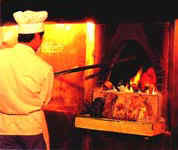 Peking Duck has the reputation of being the most delicious food in the world. The Chinese have a saying: Visitors to Beijing must do two things: climb the Great Wall and eat Peking Duck. While at Quan JuDe, ducks are roasted directly over flames from fruit-tree wood, at Bian Yi Fang roasting is done in closed containers fired with crop stalks. The best places to go for Peking Duck are Qianmen, Hepingmen and Wangfujing.
Peking Duck has the reputation of being the most delicious food in the world. The Chinese have a saying: Visitors to Beijing must do two things: climb the Great Wall and eat Peking Duck. While at Quan JuDe, ducks are roasted directly over flames from fruit-tree wood, at Bian Yi Fang roasting is done in closed containers fired with crop stalks. The best places to go for Peking Duck are Qianmen, Hepingmen and Wangfujing.
Royal Court Food
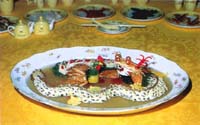 Over 800 years when Beijing served as the nation's capital, a cooking style catering to the royal court developed into a major school on a par with other national cuisine. Today, ordinary people can sample food of this cooking style, which was formerly reserved for royals only. The best restaurants offering court food are Fang Shan in Beihai Park and Ting Li Guan in the Summer Palace. Restaurants specializing in court food are not only meticulous about the quality of raw food selected, but lay great emphasis on the ambiance and decoration of the dining rooms.
Over 800 years when Beijing served as the nation's capital, a cooking style catering to the royal court developed into a major school on a par with other national cuisine. Today, ordinary people can sample food of this cooking style, which was formerly reserved for royals only. The best restaurants offering court food are Fang Shan in Beihai Park and Ting Li Guan in the Summer Palace. Restaurants specializing in court food are not only meticulous about the quality of raw food selected, but lay great emphasis on the ambiance and decoration of the dining rooms.
Feast of Complete Manchu-Han Courses (Man Han Quan Xi)
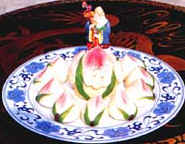 One evening in early 1993,35 Chinese and foreign tourists clad in clothes that made them the look-alikes of a Qing emperor, his queen,his concubines and court officials filed into the Fang Shan Restaurant. They were the fifth group to sample Man Han Quan Xi, or Feast of Complete Manchu-Han Courses, in the 70-year history of the restaurant. Man Han Quan Xi foods include bears' paw, hedgehog hydnum, tiger kidney, David's deer, ginseng, bracken, camel hump, shark fin, soft-shell turtle and fish skin, to name only a few. As many raw dishes come from wild life now under state protection, these courses are no longer available.
One evening in early 1993,35 Chinese and foreign tourists clad in clothes that made them the look-alikes of a Qing emperor, his queen,his concubines and court officials filed into the Fang Shan Restaurant. They were the fifth group to sample Man Han Quan Xi, or Feast of Complete Manchu-Han Courses, in the 70-year history of the restaurant. Man Han Quan Xi foods include bears' paw, hedgehog hydnum, tiger kidney, David's deer, ginseng, bracken, camel hump, shark fin, soft-shell turtle and fish skin, to name only a few. As many raw dishes come from wild life now under state protection, these courses are no longer available.
Hot Pot
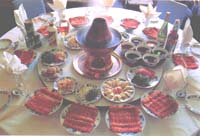 The majority of restaurants in Beijing, big or small, serve huoguo, or hot pot. Customers sit around a table on which is place a hotpot. When the water in the pot boils,they dip paper-thin slices of mutton in the water and , seconds later,get the cooked mutton out of the opt and mix them with a sauce that contains sesame butter, salted leek and a dozen other ingredients. People also cook frozen bean curd,Chinese cabbage and vermicelli in the hot pot.
The majority of restaurants in Beijing, big or small, serve huoguo, or hot pot. Customers sit around a table on which is place a hotpot. When the water in the pot boils,they dip paper-thin slices of mutton in the water and , seconds later,get the cooked mutton out of the opt and mix them with a sauce that contains sesame butter, salted leek and a dozen other ingredients. People also cook frozen bean curd,Chinese cabbage and vermicelli in the hot pot.
Moslem Flavor
After the Jin and Yuan dynasties(1115-1368), with more Hui people settling in Beijing, Moslem food consisting mainly of beef and mutton became increasingly popular in the city. Beef and mutton are cooked in many ways. Cooked mutton alone comes in dozens of varieties, including instant stewed mutton and mutton cooked in sly sauce. The best restaurant offering Mongolian hot pot in Beijing is DongLai Shun on Wangfujing Street; and the best roast mutton restaurant is the 145-year-old Kao Rou Ji beside Lake Shichahai. Also, the You Yi Shun Restaurant at Xidan is known for its fried mutton and the nearby Hong Bin Lou Restaurant for its all-mutton feast.
Folk Snacks
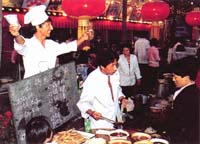 A Beijinger who has long resided abroad says: What miss most are the numerous snacks back home. Douzhi, pagao, ludagun, chatang and zhaguanchang all make the mouth water. Douzhi is a fermented drink made from ground beans; pagaois a cold food made from buckwheat flour; ludagun is a sweet millet flour cake coated, after steaming, with a layer of soy bean flour,chatang is a thin, hot gruel of sorghum flour; and zhaguanchang is fried sausage.
A Beijinger who has long resided abroad says: What miss most are the numerous snacks back home. Douzhi, pagao, ludagun, chatang and zhaguanchang all make the mouth water. Douzhi is a fermented drink made from ground beans; pagaois a cold food made from buckwheat flour; ludagun is a sweet millet flour cake coated, after steaming, with a layer of soy bean flour,chatang is a thin, hot gruel of sorghum flour; and zhaguanchang is fried sausage.
